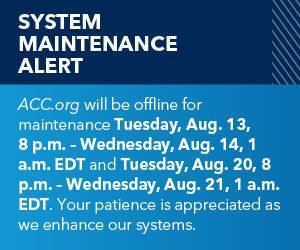Risk Stratification in Cardiac Sarcoidosis With PET
Quick Takes
- Perfusion defects on PET imaging in sarcoidosis are associated with a nearly 3-fold increased rate of MACE.
- FDG uptake on PET imaging in sarcoidosis is associated with a 2.6-fold increased rate of MACE.
- Serial PET assessment of response to immunosuppression may help guide therapy given the high MACE rate among those without response to immunosuppression.
Study Questions:
What is the prognostic value of positron emission tomography (PET) in patients with cardiac sarcoidosis?
Methods:
The authors performed a systematic review and meta-analysis of studies evaluating the relationship of PET findings with major adverse cardiac events (MACE) in patients with cardiac sarcoidosis. The authors assessed risk of bias. The odds ratio for MACE of various findings including perfusion defects, uptake on fluorodeoxyglucose (FDG) imaging, and response to immunosuppression on serial imaging were meta-analyzed.
Results:
Overall, 5,250 patients across 55 studies were combined. Perfusion defects were associated with a 2.9-fold increased risk of MACE (p < 0.0001). Abnormal FDG uptake, a finding consistent with inflammation, was associated with a 2.6-fold increased risk of MACE. Interestingly, uptake in the right ventricle had even higher risk: 6.3-fold increased risk of MACE (p < 0.001). Lack of response to immunosuppression was associated with an 8.4-fold increased risk of MACE (p < 0.0001).
Conclusions:
The investigators conclude that data from PET imaging has powerful prognostic value in patients with cardiac sarcoidosis.
Perspective:
PET scans are often used for diagnosis and therapeutic monitoring of patients with known or suspected sarcoidosis. PET scans are usually performed with a perfusion agent (such as rubidium-82 or N-13 ammonia) to identify areas of hypoperfusion related to scar/fibrosis or, possibly, edema. A second scan is generally performed with FDG in order to identify areas of inflammation. Importantly, careful metabolic preparation with a very low-carbohydrate diet is essential to avoid false positive FDG PET (20% or more of scans may be false positive or nondiagnostic even with relatively careful preparation). These scans are complex and require fastidious preparation by patients and careful interpretation by physicians. This study provides large-scale data supporting the clinical value of these efforts.
Importantly, the study does not evaluate whether these scans are more useful than other approaches or whether PET-guided management of immunosuppression improves clinical outcomes in this population. Future studies are required to evaluate those questions more rigorously.
Clinical Topics: Heart Failure and Cardiomyopathies, Noninvasive Imaging, Computed Tomography, Nuclear Imaging
Keywords: Positron-Emission Tomography, Sarcoidosis
< Back to Listings

